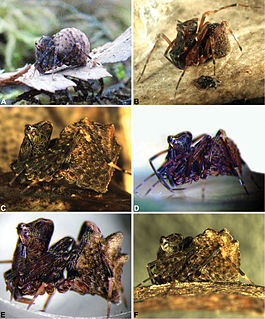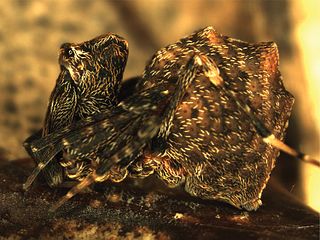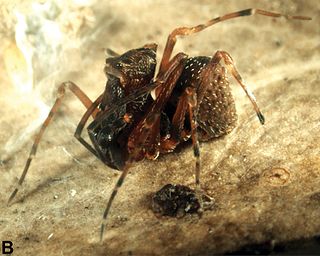Related Research Articles

Idiopidae, also known as armored trapdoor spiders, is a family of mygalomorph spiders first described by Eugène Simon in 1889. They have a large body similar to tarantulas.

Migidae, also known as tree trapdoor spiders, is a family of spiders with about 100 species in eleven genera. They are small to large spiders with little to no hair and build burrows with a trapdoor. Some species live in tree fern stems. They have a Gondwanan distribution, found almost exclusively on the Southern Hemisphere, occurring in South America, Africa, Madagascar, Australia, New Zealand and New Caledonia.

Archaeidae, also known as assassin spiders and pelican spiders, is a spider family with about ninety described species in five genera. It contains small spiders, ranging from 2 to 8 millimetres long, that prey exclusively on other spiders. They are unusual in that they have "necks", ranging from long and slender to short and fat. The name "pelican spider" refers to these elongated jaws and necks used to catch their prey. Living species of Archaeidae occur in South Africa, Madagascar and Australia, with the sister family Mecysmaucheniidae occurring in southern South America and New Zealand.

Australia has a number of highly venomous spiders, including the Sydney Funnel-web, its relatives in the family Hexathelidae, and the Redback Spider, whose bites can be extremely painful and have historically been linked with deaths in medical records. Most Australian spiders do not have venom that is considered to be dangerously toxic. No deaths caused by spider bites in Australia have been substantiated by a coronial inquest since 1979. There are sensationalised news reports regarding Australian spiders that fail to cite evidence. A Field Guide to Spiders of Australia published by CSIRO Publishing in 2017 featuring around 836 species illustrated with photographs of live animals, around 381 genera and 78 families, introduced significant updates to taxonomy from Ramirez, Wheeler and Dmitrov
Cataxia is a genus of Australian armored trapdoor spiders that was first described by W. J. Rainbow in 1914.
Euoplos is a genus of Australian armored trapdoor spiders that was first described by W. J. Rainbow in 1914.

Zephyrarchaea is a genus of Australian assassin spiders first described by Michael Gordon Rix & Mark Harvey in 2012 for nine new species and two that were formerly placed in the genus Austrarchaea. The name is based on the Latin zephyrus, meaning "west wind", referring to the western distribution in Australia and a preference for windy, coastal habitats by some species. It has been encountered in Western Australia, Victoria and South Australia.

Zephyrarchaea janineae is a species of spider of the family Archaeidae. The Latin species name was chosen to honor Janine Wojcieszek who helped in discovering the first live specimens of the species in 2006. Zephyrarchaea janineae is endemic to the South West Region in Western Australia.

Zephyrarchaea barrettae is a species of spider of the family Archaeidae. The Latin species name was chosen to honor Sarah Barrett, who first discovered assassin spiders in the Stirling Range National Park.
Bertmainius is a genus of spiders in the family Migidae. It was first described in 2015 by Mark Harvey, Barbara York Main, Michael Rix and Steven Cooper. As of 2017, it contains 7 species, all from western Australia.
Moggridgea rainbowi, also called the Australian trapdoor spider, is a small spider endemic to Kangaroo Island in South Australia. The spider was first recorded in 1919.
Bertmainius colonus is a spider in the family Migidae. It was first described in 2015 by Mark Harvey, Barbara York Main, Michael Rix and Steven Cooper, and is endemic to south-western Australia.
Bertmainius mysticus is a spider in the family Migidae. It was first described in 2015 by Mark Harvey, Barbara York Main, Michael Rix and Steven Cooper, and is endemic to south-western Australia.
Bertmainius opimus is a spider in the family Migidae. It was first described in 2015 by Mark Harvey, Barbara York Main, Michael Rix and Steven Cooper, and is endemic to south-western Australia.
Bertmainius tumidus is a spider in the family Migidae. It was first described in 2015 by Mark Harvey, Barbara York Main, Michael Rix and Steven Cooper, and is endemic to south-western Australia.

Barbara Anne York Main was an Australian arachnologist and adjunct professor at the University of Western Australia. The author of four books and over 90 research papers, Main is recognised for her prolific work in establishing taxonomy for arachnids, personally describing 34 species and seven new genera. The BBC and ABC produced a film about her work, Lady of the Spiders, in 1981.
Aname aragog is a species of trapdoor spider in the family Nemesiidae. It is found in the Pilbara region of Western Australia. The specific epithet is in reference to the spider Aragog in J.K. Rowling's Harry Potter books.

Gaius villosus is a species of spider in the family Idiopidae found in Western Australia in a variety of different habitats.

Gaius is a genus of large mygalomorph spiders in the family Idiopidae. Erected in 1914, for much of its history the genus contained only one species, Gaius villosus. More species were added in 2018. All are endemic to Western Australia.
Eucanippe is a genus of Western Australian armored trapdoor spiders first described by Michael Gordon Rix, Robert J. Raven, Barbara York Main, S. E. Harrison, A. D. Austin, S. J. B. Cooper & Mark Stephen Harvey in 2017.
References
- ↑ "Dr Michael Rix". www.qm.qld.gov.au. Retrieved 2020-02-14.
- ↑ "Michael Rix - Google Scholar Citations". scholar.google.com. Retrieved 2020-02-14.
- ↑ "Search for species author Rix", World Spider Catalog, Natural History Museum Bern, retrieved 2016-10-29
- ↑ "Search for genus author Rix", World Spider Catalog, Natural History Museum Bern, retrieved 2016-10-29
- ↑ Desmond, Rosemary (15 March 2003). "Species closes Gondwana gap". The Courier-Mail. Brisbane, Qld. p. 8.
- ↑ Pierre, Nicole (20 October 2019). "SPINNING WEB OF INTRIGUE". The Courier-Mail. Brisbane, Qld. p. 28.
- ↑ "Trapdoor spiders disappearing from Australian landscape". ScienceDaily. Retrieved 2020-02-14.
- ↑ Collard, Sarah (2018-05-16). "Rare WA 'armoured' spiders under threat from habitat destruction". ABC News. Retrieved 2020-02-14.
- ↑ "Spider discovery a first: New variety of trapdoor found in the hinterland". Sunshine Coast Daily. Maroochydore, Qld. 6 April 2019. p. 28.
- ↑ Kilvert, Nick (2020-01-18). "Ancient 'assassin' may have been wiped out by Kangaroo Island fires". ABC News. Retrieved 2020-02-14.
| This article about a biologist is a stub. You can help Wikipedia by expanding it. |